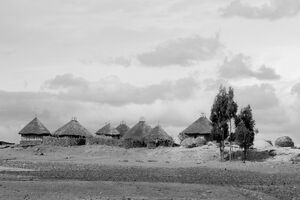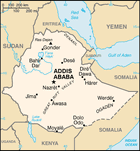Browse All Ethiopian Recipes: Ethiopian Appetizers | Ethiopian Beverages | Ethiopian Soups | Ethiopian Salads | Ethiopian Vegetarian | Ethiopian Meat Dishes | Ethiopian Snacks | Ethiopian Desserts

Ethiopian Huts

|
This article is a stub! This article doesn't contain enough information. If you know anything about Ethiopian Cuisine, please add to this article!
|
Ethiopia - Cooking and Food[]
Overview of Ethiopian Cuisine History[]
The land-locked country of Ethiopia, located on the eastern horn of Africa, is home to some of the most strikingly unique cuisines of the region. Because of the surrounding landscapes, travel was once very difficult, and therefore, in terms of cuisine, made the way for a thriving cultural existence. Today, traditional Ethiopian cuisine has gained popularity internationally, and interestingly enough, there is little difference from one Ethiopian dish to the next; many traditional Ethiopian dishes contain very similar ingredients. And like many other dishes from the area, cuisine is typically spicy and is made with a variety of both common meats and indigenous vegetables. However, as many would claim, it is the experience of an authentic Ethiopian that truly makes it something unique and enjoyable.
Cuisines of Ethiopia[]

Map of Ethiopia- Click to enlarge
Involving the use of mostly only native vegetables, spices, and meats, Ethiopian cuisine is, quite possibly, one of the most sincerely unique cuisines known internationally. It is not the types of foods that are used in meal preparation, but rather it is the simplicity of the meals that gives the local cuisine its charm. Traditional meals generally consist of a very thick meat stew, or wat, along with a few large pieces of flat bread, or Injera, which is quite similar to sourdough bread. All of these dishes are served "family-style" from a large platter, usually approximately 20 inches wide. These dishes, for the most part, will feed an entire family. Also, it is customary for one to eat the meal with one's right hand, and only the right hand, directly from the dish, using only the pieces of injera as utensils. To complement meals, Ethiopian cuisine is marked by a prime selection of fine locally brewed and fermented beers and honey wines.
As with many other cultures of the region, spices and seasonings play an important role in the cuisine as a whole. A local favorite, referred to as berbere, is a spicy, unique combination of both chile powder and other local spices.
Aside from these characteristics, Ethiopian cuisine is also shaped by the religious beliefs of citizens, as most Ethiopians are either Muslim, inhabiting the southern plain regions, or Ethiopian Orthodox Christians, who occupy the northern, more mountainous area. Below you will find specific descriptions of the traditions of each group.
By Geographic Area and Style:
- Northern Ethiopian Cuisine
- This region of Ethiopia is characterized by a high presence of Ethiopian Orthodox Christians. It is because of this that cuisine of this region is heavily influenced by religious beliefs and ideals. For example, it is a religious belief of the Ethiopian Orthodox Christians that there are many fasting days that should be observed per year: Lent, Wednesdays, and Fridays. For this reason, many of the dishes associated with this region are traditionally vegetarian dishes. Many meals will consist primarily of a few sauteed vegetables along with a few pieces of injera, a local flat bread similar to sourdough. And as Ethiopian cuisine has gained popularity internationally in restaurants, these types of dishes have become a favorite with many vegetarians from around the world seeking an alternative to meat.
- Southern Ethiopian Cuisine
- Muslims are the primary inhabitants of this low-lying region of Ethiopia. And it is no surprise that the cuisine of this area are shaped by traditional Muslim beliefs. Because of this influence, pork is a meat that is never prepared as a meal. The only meats that are acceptable for consumption are beef, lamb, and poultry (mostly chicken). These dietary restrictions lend themselves to a separation from the primarily Christian Northern regions, however, both are still uniquely Ethiopian.
General Recipes:
Preparation Methods for Ethiopian Cooking[]
Most of the preparation for Ethiopian meals is placed in a common central portion of the meal, a thick, meaty stew referred to as a wat. These stews are typically made using Beef, Lamb, or poultry (but never Pork due to religious reasons), and a variety of vegetables. Wats are prepared in generally a similar fashion: red onions are simmered and softened and added to a mixture of garlic, ginger, spices, and butter, referred to as niter kebbeh, along with berbere, a rich combination of local spices (if the preparer whishes to have a spicier wat). To top the wat off, one would add a selection of meats and vegetables, the choices of which all provide for a more unique wat.
Special Equipment for Ethiopian Cooking[]
One particular piece that is essential, not in the preparation of the foods, but the serving is a large platter. This platter is usually approximately 20 inches wide from which all prepared servings of a meal are directly served. And since Ethiopians do not require utensils to eat a meal, there is really no requirement beyond this other than typical cooking equipment. However, having a coffee grinder helps with roasting and grinding spices and maximizes their volatile oils, which, in turn, provides your food with more flavor.
Ethiopian Food Traditions and Festivals[]
Consumption of Ethiopian meals is regarded as somewhat of a tradition. Meals are prepared to serve many people from usually one or two serving dishes. However no utensils are used in serving food from these dishes, family members simply eat directly from these with their right hands, using only large pieces of bread, or injera, with which to scoop food. This tradition is important since Ethiopians believe it is a sign of complete friendship and loyalty to one another. Also, it should be noted that before a meal will commence, it is considered customary to have a hand washing ritual in which all those who are dining will participate.
Other traditions and festivals follow strict religious practices by the two predominant religious groups of the nation: the Muslims, and the Ethiopian Orthodox Christians. For example, Ethiopian Orthodox Christians believe that it is necessary to have many fasting days throughout the progression of a year: Lent, Wednesdays, and Fridays. This has led to a very broad selection of vegetarian dishes. In a similar manner, Ethiopian Muslims maintain a religious ideal restricting the consumption of Pork in any meal.
People in Ethiopian Food[]
- Are you into Ethiopian Cooking and would like to be interviewed?
